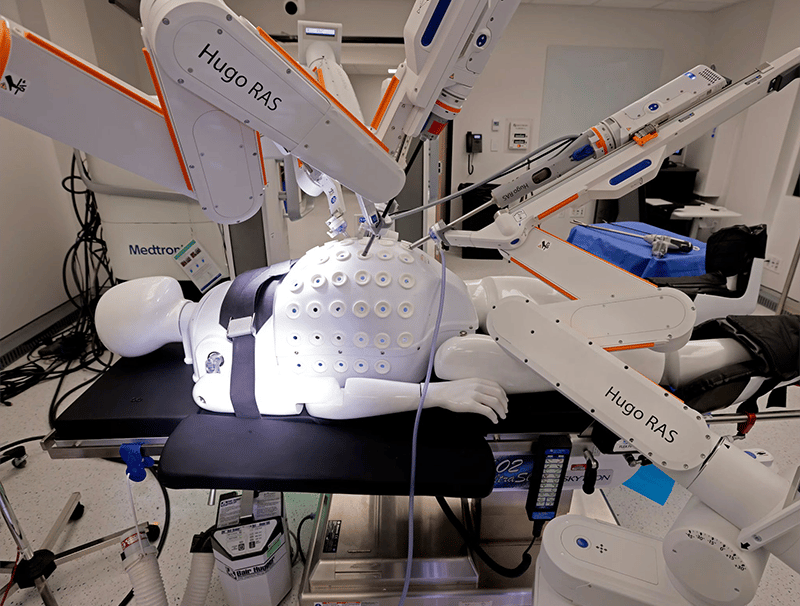Robots in the Operating Room: The Future of Surgery Is Here—Are You Ready?
4/28/20253 min read


Robots in the Operating Room: The Future of Surgery Is Here—Are You Ready?
Imagine lying on an operating table, surrounded not by a team of human surgeons but by sleek robotic arms, each moving with precision no human hand could match. Sounds like sci-fi, right? Well, it’s not. On April 27, 2025, Mario Nawfal shared a groundbreaking update on X about Medtronic’s Hugo robotic-assisted surgery (RAS) system, which achieved a jaw-dropping 98.5% success rate in 137 urologic surgeries—think prostate, kidney, and bladder fixes. With complication rates as low as 1.9% for kidney surgeries, this tech is rewriting the rules of modern medicine. But before you get too excited (or nervous), let’s dive into what this really means for the future of healthcare—and for you.
A Leap Forward in Surgical Precision
The Hugo RAS system isn’t your average medical tool. It’s a modular, multi-quadrant platform designed to assist surgeons in minimally invasive procedures. In the Expand URO clinical study, it outperformed expectations, beating the 85% success benchmark set by years of research. Only two out of 137 surgeries needed to switch to traditional methods—one due to a glitch, the other due to a complex patient case. For context, complication rates were 3.7% for prostate surgeries and 17.9% for bladder surgeries, both well below safety targets. As James Porter, M.D., from Medtronic, noted, this system is a game-changer for enabling minimally invasive surgery, which means smaller incisions, less pain, and faster recovery for patients.
But here’s the catch: the Hugo system isn’t operating on its own. Despite the buzz, surgeons are still in control, using a console to guide the robotic arms with enhanced precision. X users like @alohacowboysol and @alex_rothe were quick to clarify this, pointing out that robotic-assisted surgery (RAS) isn’t the same as fully autonomous robot surgeons. The robot is more like a highly skilled assistant—think of it as a surgeon’s “metal sidekick,” as Nawfal put it.
The Bigger Picture: Robotics in Medicine
This isn’t an isolated breakthrough. The same day, Elon Musk chimed in on X, revealing that Neuralink had to use a robot to insert brain electrodes for its brain-computer interface (BCI) implants because humans couldn’t match the required accuracy. Musk boldly predicted that robots will surpass good human surgeons in a few years, and the best ones within five. Neuralink’s tech is already helping patients, like an ALS patient who regained speech through the implant, as reported by the Daily Mail on April 28, 2025. The implant, paired with AI like Musk’s Grok, lets patients control devices just by thinking, a feat that’s nothing short of miraculous.
Meanwhile, other innovations are making waves. A tiny dissolvable pacemaker, smaller than a grain of rice, is offering hope for newborns and adults with heart defects. Shared in an earlier X post by Nawfal on April 3, 2025, this device can be implanted with a syringe, avoiding invasive surgery and reducing risks like infection and tissue damage. It’s a glimpse into how robotics and miniaturization are tackling some of medicine’s toughest challenges.
The Debate: Promise vs. Peril
The reactions on X tell a story of excitement mixed with caution. Some users, like @Maggie82616346, expressed skepticism about robots in surgery, longing for the “loving care” of human doctors. Others, like @SarahSmith, admitted to finding the idea “terrifying,” picturing a future where humanoid robots dominate operating rooms. On the flip side, @Ceo_Branding highlighted the benefits: precision, speed, and zero fatigue. But they also posed a critical question: Are we ready for a world where humans aren’t the gold standard anymore?
Experts are weighing in, too. @jselanikio pushed back on the hype, noting that current surgical robots can’t work autonomously—zero fully autonomous robot surgeons exist today. @RealChrisLangan echoed this, emphasizing that robots lack human consciousness and situational awareness, requiring extreme control to avoid errors. These concerns aren’t just theoretical; they point to real challenges in regulation, ethics, and trust as this technology evolves.
What’s Next for Robotic Surgery?
The trajectory is clear: robotic systems are becoming more integrated into healthcare. Medtronic’s Hugo system is awaiting FDA approval, and Neuralink’s advancements are paving the way for broader applications, from restoring sight to enabling telepathic communication. But as we race toward this future, we need to address the gaps. How do we ensure equitable access to these expensive technologies, as @Maggie82616346’s exchange highlighted? How do we balance innovation with the human touch that patients crave? And what happens when—not if—robots start making autonomous decisions in the operating room?
The future of surgery is bright, but it’s also uncharted. Robotic systems like Hugo are already transforming lives, and with pioneers like Musk pushing the boundaries, we’re on the cusp of a medical revolution. The question is, are we ready to embrace it?
Let’s Talk: What Do You Think?
- Would you trust a robotic system to assist in your surgery, or does the idea make you uneasy?
- How do you feel about the prediction that robots could outperform human surgeons in just five years?
- What’s more important to you in surgery—the precision of a machine or the empathy of a human doctor?
Share your thoughts—I’d love to hear where you stand on this cutting-edge topic!
Photo Credit: X,@MarioNawfal
hello@boncopia.com
+13286036419
© 2025. All rights reserved.